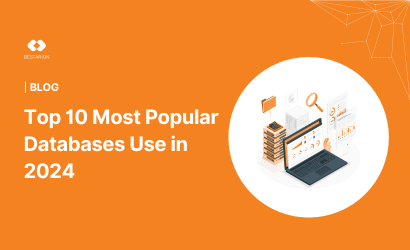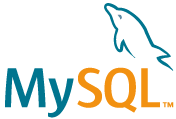Top 10 Most Popular Databases in 2024


In the ever-evolving landscape of data management, databases play a crucial role in storing, organizing, and retrieving information efficiently. As we approach 2024, the demand for robust and scalable database solutions continues to grow across various industries, especially IT industry.
It’s no surprise that database administrator roles are increasingly in demand in IT, with a yearly growth rate of 9% according to the US Bureau of Labor. With new job opportunities emerging regularly, newcomers often wonder which databases are most widely used in the industry.
From traditional relational databases to modern NoSQL and cloud-native options, the choices are vast and tailored to diverse needs. This article explores the ten most popular databases poised to dominate in 2024, highlighting their features, advantages, and notable use cases.
10 Most Popular Databases to Use in 2024
Relational databases are structured around tables, where data is organized in rows and columns. They use SQL (Structured Query Language) for querying and managing data. Here are two key relational databases to consider:
1. Oracle
Oracle is a widely acclaimed RDBMS written in C, C++, and Java assembly languages. The current iteration, Oracle Database 19c, stands as a testament to its ongoing evolution, although many organizations still utilize versions 11g and 12c. Renowned for its robust security and efficient data processing capabilities, Oracle Database also offers a comprehensive documentation.
Pros
- Advanced Features: Introduces innovative capabilities such as JSON support in SQL.
- Cloud Functionality: Provides robust cloud integration capabilities.
- Document Store: Facilitates storage and retrieval of document-oriented data.
- Key-Value Storage: Offers efficient management of key-value pairs.
- Graph DBMS: Supports complex data relationships through graph database functionalities.
- PDF Storages and BLOBs: Manages large binary objects and PDF documents efficiently.
Cons
- The cost can be high, which makes it difficult for smaller organizations to afford.
- Using the Oracle database often requires frequent upgrades to existing hardware.
Oracle Database is renowned for meeting diverse needs in performance, scalability, high availability, security, and data warehousing. It supports multiple versions of Windows, UNIX, and Linux, ensuring broad compatibility and operational flexibility across different environments.
2. MySQL
MySQL is a highly favored open-source RDBMS, prominently utilized by leading tech giants such as Facebook, Google, Twitter, and Adobe. It became part of Oracle through Sun Microsystems’ acquisition in 2009. Written in C and C++, MySQL employs structured query language (SQL). The latest iteration, MySQL 8.0, introduces enhanced recovery options.
Pros
- Widely adopted in web development due to its robust performance.
- Ensures data security with advanced access control mechanisms.
- Provides flexibility in data handling and maintains reliability in operations.
- Supports various programming languages including C, C++, Java, Perl, PHP, Python, and Tcl for client-side programming.
- Facilitates storage and processing of Unicode characters.
- Includes support for replication, transactions, full-text search, triggers, and stored procedures.
- Capable of handling large databases, scaling up to 50 million rows or more per table.
- Operates seamlessly on Linux, Windows, OSX, FreeBSD, and Solaris platforms.
Cons
- Setting up MySQL requires manual effort and incremental backups.
- It lacks built-in support for XML or OLAP.
- Technical support is only available to paid users.
MySQL’s versatility and comprehensive feature set make it a preferred choice for developers aiming to build robust and scalable web applications across various operating environments.
3. PostgreSQL
This database is also an open-source Object-Relational DBMS that allows users the flexibility to create NoSQL databases as needed. Written in C, its popularity continues to grow steadily. It is particularly well-suited for organizations handling large volumes of data, making it a preferred choice for gaming apps, database automation tools, and domain registries. Major companies like Apple (which utilizes this database in macOS Server), Cisco, Fujitsu, Skype, and IMDb also rely on it. PostgreSQL operates seamlessly across multiple operating systems, including Windows, Linux, Solaris, and now Mac OS X.
PostgreSQL is versatile, suitable for both single-machine applications and large-scale internet-facing applications. It excels in creating fault-tolerant environments, managing data effectively, and ensuring data integrity.
Pros
- High scalability and performance.
- Predefined functions and extensive support for JSON data.
- Easy data portability and compatibility through multiple interfaces.
- Support for tablespaces, stored procedures, joins, views, and triggers.
- Robust security features and comprehensive disaster recovery mechanisms.
- Extensibility via stored functions, procedural languages, and foreign data wrappers.
- Capability to define custom data types and query methods.
Cons
- Due to limited configuration guidance, users may find setting up on their own confusing, requiring additional time online to locate resources.
- Importing data in bulk can be significantly slowed down by speed limitations.
4. Microsoft SQL Server
Microsoft SQL Server, introduced in 1989, ranks among the most widely-used relational database management systems (RDBMS) globally. Developed in C and C++, it supports structured query language (SQL). The most recent iteration, SQL Server 2019, integrates seamlessly with Microsoft products and operates on both Windows and Linux platforms. This versatile database offers numerous editions including Azure SQL Database (cloud-based), Compact Edition, Enterprise Edition (preferred by many organizations), and Developer Edition.
Pros
- Platform-specific, delivering high performance.
- Utilizes data compression to optimize storage efficiency.
- Capable of integrating with non-relational sources such as Hadoop.
- Implements robust security measures like row-level security, dynamic data masking, transparent data encryption, and comprehensive auditing.
- Features custom graphical tools that enhance user productivity.
- Includes Object Explorer for streamlined table creation and management.
- Facilitates intuitive design, table creation, and data visualization without the need for extensive syntax.
- Efficiently manages workloads and supports concurrent usage by multiple users.
Cons
- The pricing may be relatively high for smaller organizations.
- Importing files using SQL integration services can be difficult and challenging at times.
5. MongoDB
MongoDB is a versatile NoSQL database that operates across multiple platforms. It is implemented using C++, C, and JavaScript programming languages. MongoDB finds applications in mobile apps, real-time analytics, and IoT environments, offering real-time access to all data. Data in MongoDB is stored in JSON-style documents, ensuring high-speed access through its use of internal memory. It excels in handling large volumes of data simultaneously.
Pros
- Known for its high-speed operations and user-friendly interface.
- Facilitates horizontal scaling by distributing data across multiple servers.
- Offers flexibility in deployment options.
- Ensures robust performance and high availability of data.
- Easily scales to accommodate growing datasets and user loads.
- Stores data in JSON format, allowing schema flexibility without downtime.
- Simplifies administration tasks, especially in handling failures.
- Provides comprehensive deployment options for seamless data migrations.
- Allows for efficient optimization of queries to improve performance.
Cons
- Vulnerable default settings.
- Lengthy setup process.
- MongoDB prioritizes performance and scalability over full ACID compliance. It supports transactions at the document level but lacks complete support for multi-document transactions spanning multiple collections or databases.
6. Redis
Redis, an open-source in-memory data structure store, supports a wide array of functionalities including database, cache, message broker, and streaming engine capabilities. It enables partial resynchronization during network splits and offers asynchronous replication. Redis leverages memory datasets for superior performance. Its focus on memory efficiency means that data structures implemented within Redis typically consume less memory compared to equivalents developed in higher-level programming languages.
Pros:
- Exceptionally fast with in-memory storage.
- Supports diverse data structures.
- Enables execution of custom scripts on the server.
- Ideal for caching frequently accessed data.
Cons:
- Limited by available RAM.
- Operates on a single thread.
- Requires substantial memory, which can be costly, like other in-memory databases.
- Supports limited multi-key ACID transactions.
7. Elasticsearch
Elasticsearch is a search engine built upon the Lucene library, known for its distributed and open-source nature, designed for full-text search and analytics. It features a distributed, multi-tenant capable architecture, offering a web interface over HTTP and supporting schema-free JSON documents. Many prominent organizations such as Wikipedia, The Guardian, StackOverflow, and GitHub utilize Elasticsearch. Key features include:
Pros:
- Supports replication of indexes and shards.
- Scalable to handle petabytes of both structured and unstructured data.
- Provides multi-tenancy and delivers exceptionally fast search results.
- Written in Java and optimized for real-time operations.
- Document-oriented with high-performance outcomes.
Cons:
- Setup and configuration, particularly in distributed and production environments, can be complex.
- Effective scaling of Elasticsearch clusters remains a challenge.
- Prioritizes speed and search efficiency over strict consistency, which may not suit all applications.
8. IBM DB2
DB2, a standout offering from IBM, is a cloud-native database compatible with Windows, Linux, and Unix platforms. Designed to operate on IBM iSeries servers, this engine supports NoSQL functionalities like JSON and XML.
The latest iteration of this database engine introduces over 50 enhancements, featuring support for Machine Learning algorithms and Augmented Data exploration. With RMDA support, users can boost database performance by up to 40% and achieve 1.5x faster LOAD times.
Pros:
- Capable of hosting on both physical servers and in the cloud.
- Supports concurrent execution of multiple tasks via the Task Scheduler.
- Utilizes Blu Acceleration to maximize resource utilization for large-scale databases.
Cons:
- Free support is limited to the initial three years.
- Costs may exceed the budgets of many individuals and small organizations.
- Setting up clusters or multiple secondary nodes may require third-party tools or additional software.
9. MariaDB
MariaDB, a community-developed fork of MySQL, retains compatibility with MySQL while introducing enhancements and new features. It emphasizes performance, scalability, and open-source collaboration, offering enterprises a reliable alternative to MySQL. MariaDB’s active community and transparent development process ensure rapid innovation and continuous improvement in database technology.
Key Features:
- Enhanced performance optimizations.
- Support for JSON and XML data types.
- Multi-version concurrency control (MVCC).
Use Cases: Google, WordPress.com, Wikipedia.
10. SQLite
SQLite is the world’s most popular self-contained, serverless database management system provided as a software library. The name “lite” signifies its ease of setup, database management, and resource usage. SQLite can be deployed in diverse environments, including embedded devices such as iPhones, Android phones, gaming consoles, and portable media players. Currently, 14,523 companies utilize SQLite, commanding a market share of approximately 1.5%.
Pros:
- As a serverless and self-contained database, SQLite requires no separate server process and can be easily embedded within applications.
- Operates using a single database file.
- SQLite is lightweight and compact, ideal for resource-constrained environments like mobile apps or embedded systems.
- Supports ACID properties, ensuring data integrity and reliability.
Cons:
- SQLite operates in a single-writer/multiple-reader mode, which may restrict concurrent writing operations.
- Managing complex joins across multiple tables can be more challenging compared to traditional RDBMS.
- Not well-suited for very large datasets or high-performance requirements.
- Lacks certain features found in more advanced database systems, such as stored procedures and triggers.
Choosing the Right Database
When selecting a database for your project, consider factors such as data structure, scalability requirements, performance needs, and the nature of your application. Each database type has its strengths and ideal use cases, so understanding these distinctions will help you make informed decisions.
Conclusion
As we look ahead to 2024, the landscape of database technologies continues to evolve rapidly, driven by the increasing demand for scalability, performance, and flexibility. Each of the databases highlighted in this article offers unique strengths and capabilities, catering to a wide range of application requirements and use cases. Whether you prioritize traditional relational databases like MySQL and PostgreSQL or opt for modern NoSQL solutions like MongoDB and Redis, the key lies in choosing a database that aligns with your specific needs for data storage, retrieval, and management. With ongoing advancements in cloud computing, artificial intelligence, and data analytics, the role of databases as foundational elements of digital infrastructure will only continue to expand in the years to come.
Bestarion Website Admin






